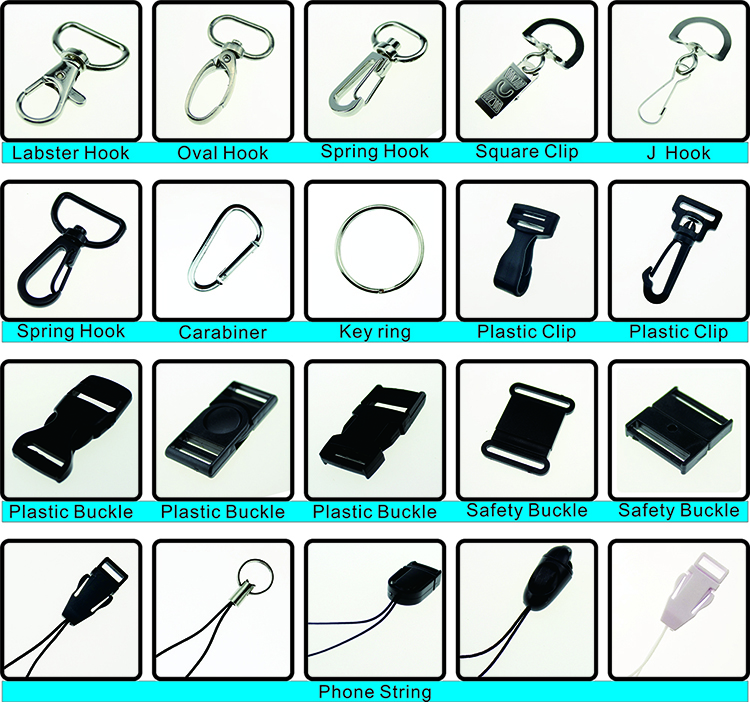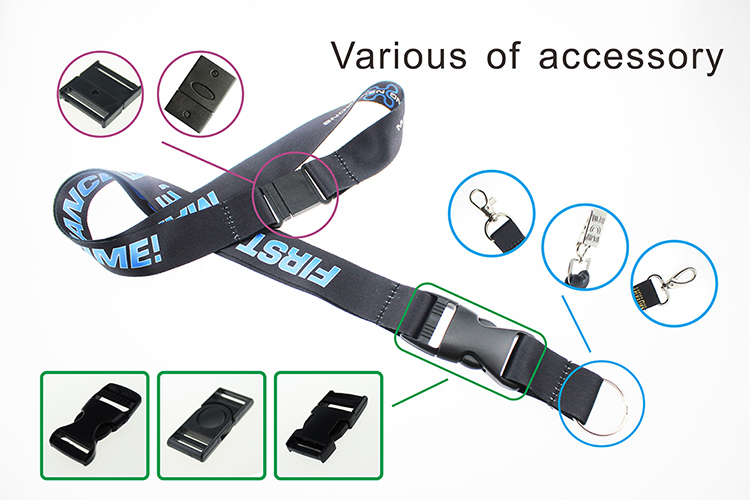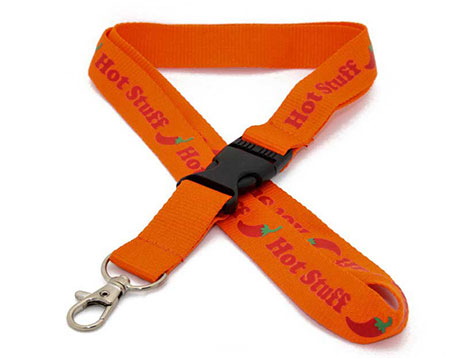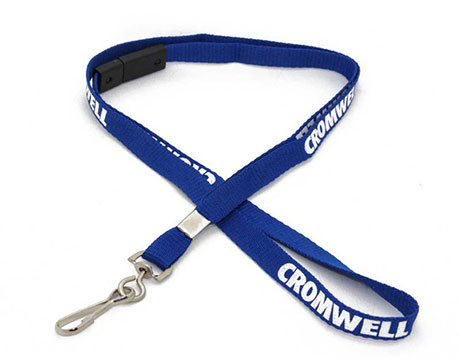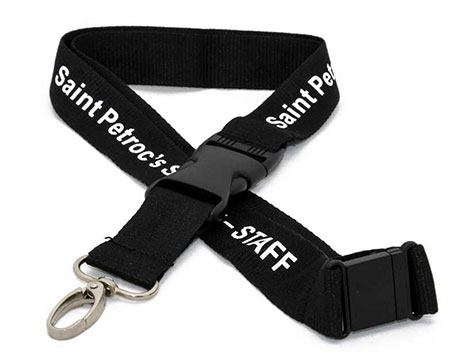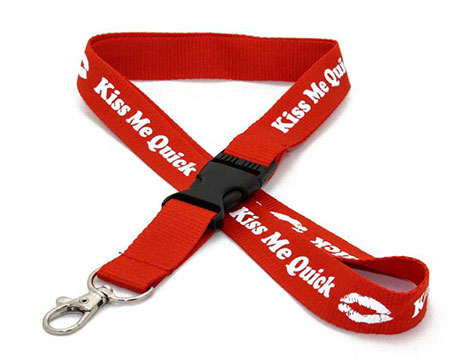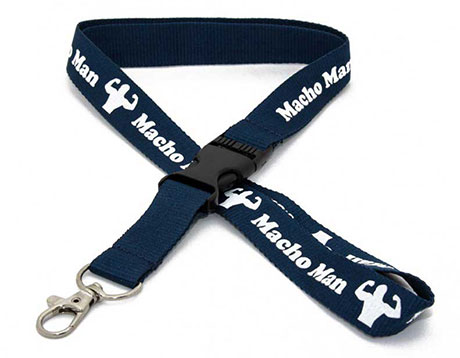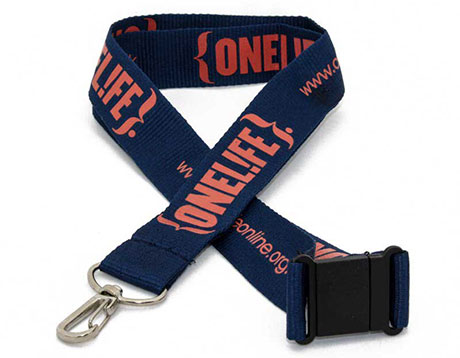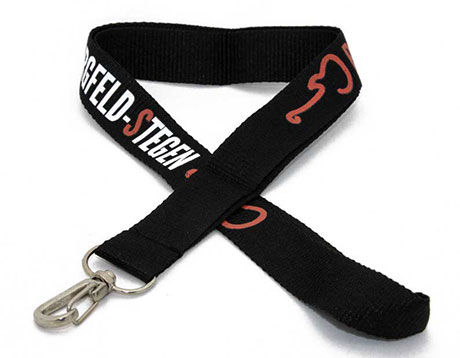Screen Printed Lanyards
Screen printed lanyards also called silk screen lanyards, are some of the oldest ways of transferring text or logo to fabric or other materials.
If you are designing a lanyard that is straightforward and does not require a lot of colors and details, you may find that screen printed lanyards will suit your purposes.
iLanyards is a reputable wholesale and custom screen printed lanyards factory in China.
- Set up the logo or text, artwork. Choose a Pantone color that matches your requirements or we’ll do it according to your request.
- We send scans or photos after setting up correct logos by email for customer’s approval before production
- The process involves making a print of your logo on a mesh screen and forcing the ink through the mesh onto the lanyard fabric.
- After finishing, printing material, wet heat must be applied to dry the wet ink. This will make it more durable.
iLanyards Custom Screen Printed Lanyards
The silkscreen printing is one of the popular methods in the production lanyards.
Custom screen printed lanyard is widely used for company lanyards, exhibition lanyards, school lanyards, and promotional lanyards etc.
The most common materials used for custom screen printed lanyards are Nylon, cotton, and polyester – all of them are eco-friendly materials.
The tightly knitted and smooth surface of polyester and Nylon, make these materials No. 1 choice for custom screen print Lanyards.
And, the tightly knitted twill construction cotton materials are best for custom screen print lanyards too.
At iLanyards, all we get is a high-quality lanyard product after printing.
The technology has been around for more than a thousand years, and it was documented during the Song Dynasty (AD960 to 1280) in China. You can use this screen printed technology for the mass production of playing cards.
For more information or any technology, contact us here, please.
- Screen Printed Lanyards
- Attachment
- Gallery
Screen Printed Lanyards
The Ultimate Guide
Screen printed neck lanyards are more than a string designed to hold your name card or ticket concert.
They possess multipurpose features and specs. Their versatility sky-rocketed demand and sales.
Introduction
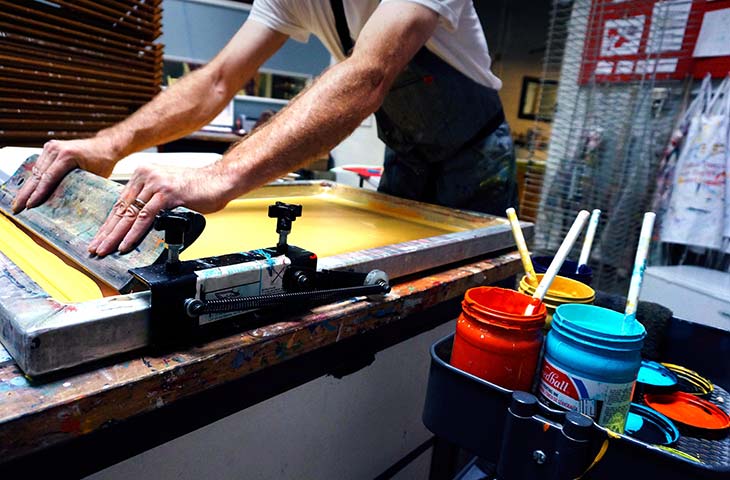
Screen Printed Introduction – Image source: Same Day Tees
Nowadays, competition is fierce is all domains. You need to have a clear and out-of-the-box marketing strategy to stand out. Plus, you must strengthen your customer’s loyalty.
What better way to do this than giving them tokens as a symbol of your appreciation?
Custom T-shirts, mugs, and bags are traditional advertising products people expect to receive.
Personalized printed lanyards are an unanticipated and well-received gift. The effect is remarkable when the wearer sees his/her name and position on them. This shows you place great value on your clients’ experiences.
Let’s not forget about the security functions of these cords. Employees, students, and conference attendees love imprinted lanyards with a cool design.
Since customization plays such an important role, our team decided to reveal to you a few screen printing facts.
Keep reading:
Chapter 1. What is Screen Printing Anyway?
Does the word serigraphy ring a bell to you?
Probably, because it refers to one of the oldest methods used to imprint artwork on fabrics.
Some people name it silk screen printing. But the dissimilarity is only in the name, not in the process.
1.1.A Concise Screen Printing Definition
Trained workers put a screen or a mash on the material. The ink is forced through the stencil to reproduce a pattern, logo or text.
This procedure used to be laborious because each shade requires a new screen. The technological development simplified and quickened color application.
As we manufacture printed lanyards, we will give you information and tidbits on textile types of screen printing.
Companies specialized in producing posters, banners, and billboards employ this method on a large scale.
1.2.The History of Screen Printing Technique
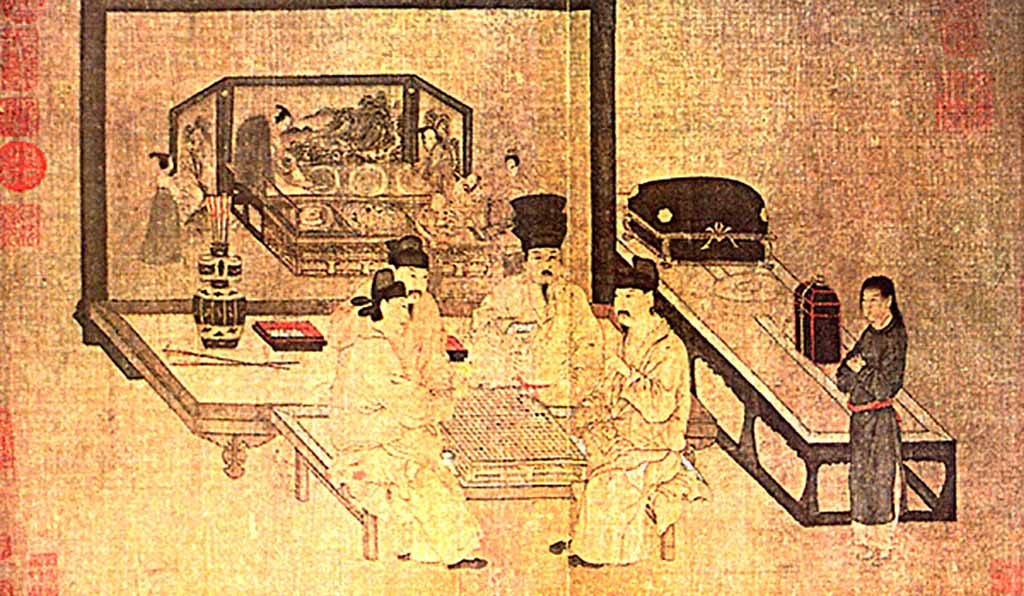
History of Screen Printing – Image source: T shirt Co
The Ancient Period
Archeological discoveries point out that this process emerged in China during the rule of the powerful Song Dynasty. Its representatives occupied the throne from 960 AD to 1279 AD.
Wandering craftsmen spread the new skill in Asia. It crossed the sea in Japan where experienced traders recognized its commercial value.
As it is with all things from the dim and distant past, the origins of the screen printing kit are questioned.
Some historians believe the Egyptians invented it in 3000 BC. Another group of scholars is convinced that the Indians had the idea between 400 AD and 499 AD.
The Industrial Revolution
Asian merchants brought lots of exquisite silk printed garments to Italy, Spain, France or England. The European clothes manufacturers installed screen printing equipment in their workshops in the late 18th century.
The end products were expensive even for the rich. So, the process gained popularity when silk became more affordable.
Victorian visionary entrepreneurs grasp the advertising potential of screen printing.
Modern Times
In the first years of the 20th century, lots of printers conducted experiments to improve the technology. Developers like R. Beck, E. Owens, and Ch. Peter invented the photo stencils.
The artists introduced the word serigraphy to distinguish between the artistic and commercial use of the technique.
The real boom came in the 1960s when Andy Warhol and other talented creators adopted the procedure to express themselves.
Michael Vasilantone was an ordinary businessman with a textile factory. The slowness of the screen printing process annoyed him.
The American decided it was time to do something about it. After several attempts, he came up with the dual rotary screen printing press.
It worked faster than any other equipment. Soon, T-shirts with logos, messages, and patterns were a common sight.
Chapter 2. The Screen Printing Process
Do you ever wonder how are lanyards printed?
Let us tell you more about the secrets of the trade.
2.1. Types of Screen Printing
There are two broad categories:
A.Manual Printing
The activity is performed without the aid of fancy gear. Certain artists prefer working alone while others in teams of two.
In the second case, one person keeps the screen in the right position and the other covers it with ink.
Which are the right manual movements to get qualitative products?
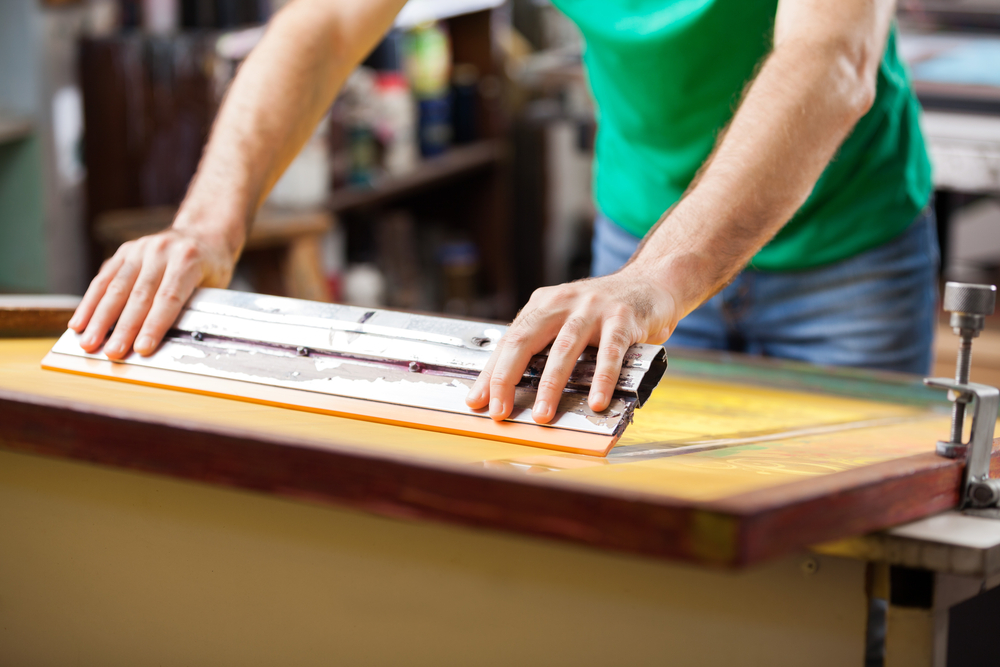
Printing – Image source: Custom Logos
You can either pull or push the squeegee. Most individuals do not know that this simple answer is a heated topic for debates.
Advocates of the pulling “school” claim that this move grants higher control over the squeegee. The ink reaches the hard to get areas and fine details are better outlined.
The supporters of the pushing method allege that it is more comfortable for the body. They say pulling creates tension in the fingers and wrists.
After years of practice, this leads to chronic pain. If you push the squeegee pressure moves to the torso and the shoulders. But, it is difficult to get the liquid at the corners.
An expert printer masters both moves and figures it out when to apply them.
B.Automatic Printing
Factories with automatic devices and workshops centered on manual printing follow the same manufacturing steps.
Is there any difference then?
The hand-printing activity is time-consuming. Plus, only a few items are decorated per day.
Machines have bigger meshes, proficient drying systems, and rotary mechanisms which speed up production.
C.Screen Printing DIY
Promoting an event on a shoe-string budget is not an easy task. To save funds, you could manufacture stunning DIY cords.
It is normal to be worried by the question: how to make printed lanyards?
Almost all questions have an answer. Here is the solution to your problem!
You will need screen printing equipment which comprises:
- screens
- panels of glass
- a piece of black cloth
- emulsion + ink; if you enter the beginners’ category go for inks based on water
- one sharp cutter
- a roll of masking tape
- a squeegee
You ought to follow the same procedures as the pros. But, there is a lot of room for twists and improvisation.
Here is what you must do:
- get the artwork done; choose a simple model with straight lines
- wash and dry the screens
- apply the emulsion
- dry the mesh with a hair-dryer
- position the black cloth under the screen
- lay the meshes under bright sunlight
- wash the screen for a second time
- use strips of masking tape to fix the ink on the interior part of the screen
- imprint the fabric; do this on a flat surface with a squeegee
- hang dry and iron your products
DIY activities might be frustrating for newbies. Homemade lanyards are not an exception to that. Be prepared to try several times before getting the item you wish for. Also, you can click here to learn more about how to create your own lanyards
2.2. The Screen Printing Process Step by Step
As pointed out, this technique is not complicated. The end-products are extraordinary as long as each phase is completed by the book.
Phase #1. Make an Awesome Artwork
In case you partner with us, you have two alternatives for decorating your screen printed lanyards.
Option A. Be the Creator of Your Design
You choose the colors, the material, the printing technique, and the accessories you want.
The next step is to place the order via email. Do not forget to attach your logo, text, and other graphic elements.
We prefer .eps, ai, or .cdr files. You shouldn’t worry if you possess only .jpg files. As long as the image is crystal clear, we will render the vector for you.
The lanyards designers will send you photos, scans, and a free sample of the object. They will operate any changes you desire.
Production begins the moment we receive your written consent.
Option B. Let Us Help You
It is all right to wish an amazing item but to have no idea where to start from. Our employees are creative and familiar with the latest trends and technologies.
Tell them the story behind your company and your business philosophy. The designers will grasp the essence of your message and fashion the perfect item for you.
They know all the subtleties of graphics software like Corel Draw, Photoshop, and Adobe Illustrator. These tools allow them to work with separate layers.
You will receive samples and manufacturing begins after your approval.
What about Vectors and Pixels?
Vector graphics are made of paths with two exact ends. A path can take the form of a square, triangle or a simple line.
The vector images do not lose their clarity when maximized or minimized.
Pixels are the tiniest bits of information which compose a picture. Their form is that of colorful squares or circles. Their number represents the image resolutions.
Lots of pixels mean a higher resolution which in its turn equals more details.
Low-quality pictures get the pixelated aspect when extended.
For these reasons, vectors are preferred to pixels with custom printed lanyards.
Phase # 2. Pre-printing Actions
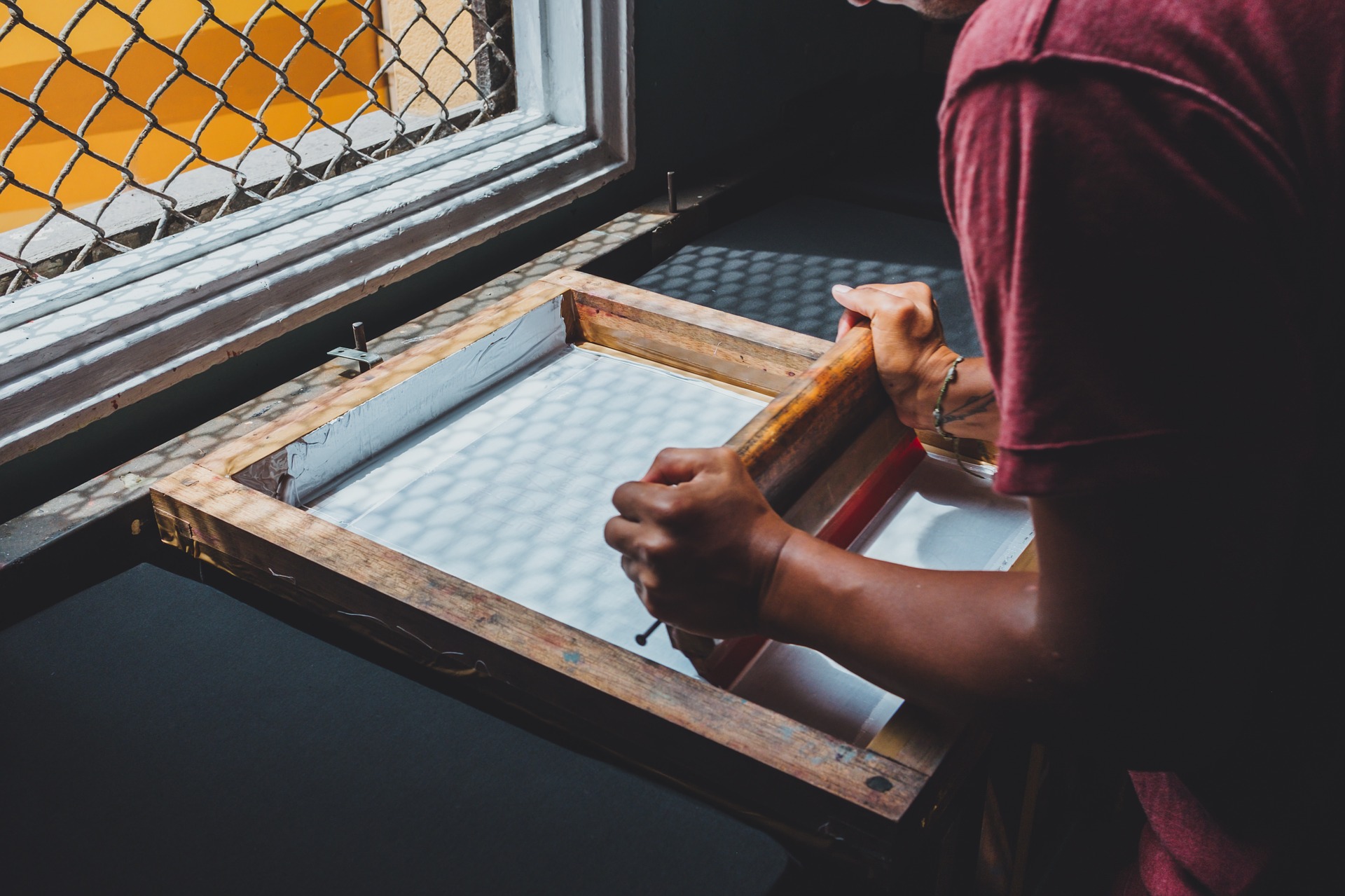
Pre-Printing – Image source: Pixabay
The screen printing technique is affordable for both big and small scale companies. Professionals or amateurs may use an automatic screen printing machine for their passion.
Lots of artists and individuals, who dedicate their free time to serigraphy, opt for the manual alternative.
First, the screen is coated with a special emulsion. The worker must pay attention to cover perfectly every inch. If too much liquid gathers in one point, the end-product will have a sloppy aspect.
The mesh is taken into a dark, moisture-free room. It stays in there until it dries.
A laborer applies the design on the mesh. Areas under the design retain their softness while the rest get scorched. Success is guaranteed if the activity is unfolded below the powerful light.
One hour later the design is wiped with utmost care.
Phase# 3. The Production of Custom Imprinted Lanyards
The mesh is put on the fabric and the duo is placed on the press. Then, the layer of ink is spread on the screen with a squeegee.
If the artwork has two or three colors, they are not applied at the same time. To avoid unpleasant occurrences, most producers use different screens for separate shades.
The strap of fabric is dried in a machine or with a special device. After that, the items are packed and delivered.
2.3. Screen Printing Supplies
Your kit will differ according to the technique you decide to use.
However, the basic items are the same. They include a wooden or a metal frame, a monofilament mesh, photographic polymer emulsion, a squeegee, and ink.
More good stuff on screen printing ink colors
This technique requires special inks, which have a sticky consistency.
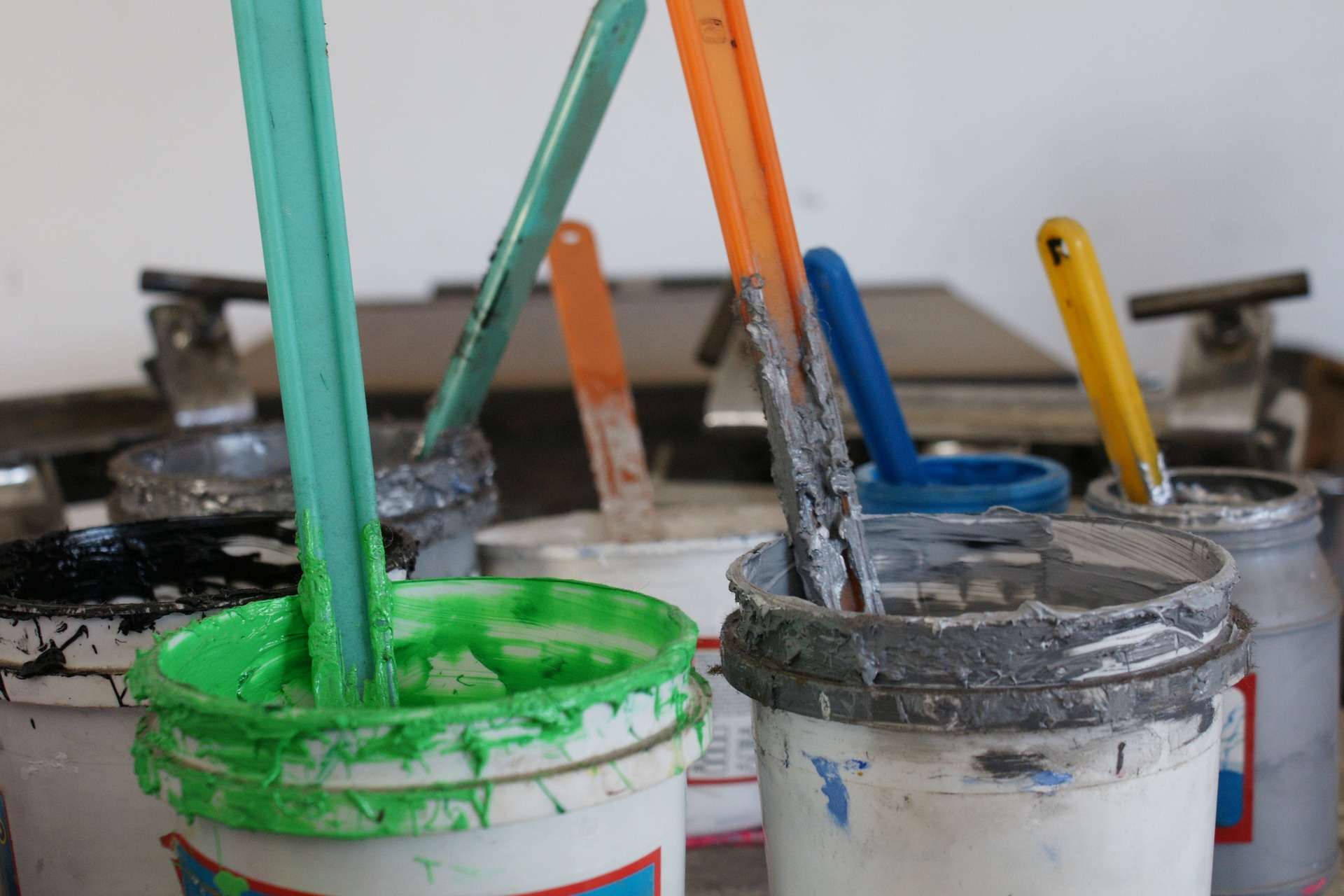
More Ink Colors – Image source: Pixabay
In case the liquid is too thick, you’d better pour in it a small amount of curable reducer.
Tip: never forget to stir the ink; if it has a creamy texture, you do not need the reducer
Dye migration is a common phenomenon encountered when printing on polyester. Tiny dye particles relocate themselves. As a result, the tint suffers changes.
The solution is to purchase inks made to adhere to polyester. Another alternative is to mix with an additive.
Nylon also needs inks with a special formula.
Water-based ink and plastisol are the wisest choices when customizing a cotton lanyard. The latter do no dry while on the screen. They have in their composition PVC resin and a clear liquid named plasticizer.
Plastisol ink dries only when subjected to heating.
How to choose the best squeegee?
The craze of the day is the triple durometer squeegee. Its edges are soft and the center is sturdy.
More traditional printers prefer a product with sharp edges and with a lighter middle part.
The quality of each article is essential for the final products. An untrained printer or a second-hand ink might damage your image.
Chapter 3. Screen Printing Advantages and Disadvantages
Although it has been perfected over the centuries, the technique has its pluses and minuses.
What makes it popular?
Lanyards customized with this procedure have a smooth touch. The shades are vibrant and visible from the distance. Plus, the logo and the text don’t peel off.
The colors last for a long period. They do not fade away after washing and drying.
If you own a first-class press, you can adorn objects in a matter of seconds. Two to three shades may be imprinted on the fabric.
It is the most suitable option for bulk printed lanyards. For example, one of the best screen printing machines has the capacity to print thousands of items per hour.
This procedure is adaptable. Companies specialized in advertising articles employ it to customize plastic, wood or metal objects.
Which are its weak points?
It is not indicated for small size orders. In addition, the learning curve is ample. Even skilled manual workers drop ink on the floor or stain their clothes.
The printing part is fast, but the preparation requires time and effort. Thus, the screen printed items may seem pricey. Their durability equals the balance.
There is the possibility to print complex logos with this method. But, the screens must be changed for each shade. This aspect increases the final price.
The screen printing technique works best with simple artwork. Maximum three colors should be used to keep costs under control.
Chapter 4. Screen Printed Lanyards by Material
The images printed on lanyards and the string itself must pass the test of time. They must resist in adverse conditions.
An element which makes a very important difference is the quality of the fabric. Flawless design loses its shine on a second-hand background.
As already mentioned screen printing has a startling effect on polyester and nylon. The results are fantastic on other materials too.
- Pre-printed lanyards made of polyester are a common sight. They are cost-efficient and easy to clean. There are several types of polyester:
- 1.standard—the most widespread
- 2.reinforced—solid, ideal for harsh environments
- 3.smooth—the comfiest to wear
- Custom printed nylon lanyards are an excellent pick for elaborated logos and intricate letters. This fabric has a genuine sheen, giving the artwork a particular touch.
It is versatile, so manufacturers employ it for the production of flat and tubular items. - Cotton lanyards have a soft touch and not sharp edges. They are so snug that you can place them around a child’s neck.
You may also buy printed lanyards which have in their composition silk, dacron, satin, bamboo or recycled plastic.
Chapter 5. Screen Printed Lanyards by Purpose
When most people hear the word lanyard, they think at a colored string fasten to hold a security card or a badge.
Let us astonish you with the other many uses of bespoke printed lanyards.
5.1. Event Lanyards

Event Lanyards – Image source: Pixabay
You need them for guests’ identification, security, and promotion. These strings may prevent unpleasant situations like a fan trying to sneak at a celebrity’s party.
People like taking part in important conferences, seminars or fairs. They will keep a first-class cord imprinted with the name and the date of the event. For an optimum result, your logo should be visible from the distance.
Nice, colored twines should not miss sports championships, festivals, music concerts, and fundraisings. Sponsors, VIPs, and the public like to receive them. Some even own a collection.
They are amazing to spice up a wedding, a private party or a ceremony. The guests will appreciate your desire to make them feel special and welcomed.
Union printed lanyards must not miss form important gatherings.
5.2. Marketing Beacon
Printed lanyards from China are a useful advertising tool. They are not only for event use.
You can give them as gifts to your loyal customers. They do wonders during social and promotional campaigns.
Imagine you are the owner of a bookstore who has to host a famous author’s novel launch. You should order custom printed neck lanyards and hand one to each attendee.
Offer them a substantial discount the next time they come to your shop and bring the lanyard with them.
The visitors to your company or institution will be impressed if they see all staff members with corporate printed lanyards. It conveys order and professionalism.
5.3. Printed Staff Lanyards

Staff Lanyards – Image source: Photo by Hello I’m Nik on Unsplash
In crowded buildings like schools, colleges or hospitals, it is paramount to spot different employees fast.
It is easier for parents to identify teachers, students’ councilors, coaches or administrative personnel if these wear custom printed id lanyards. They are more effective when the position is written on the cord.
Printed lanyards for schools are must in order to maintain a safe environment for the kids.
All students ought to wear lanyards printed with the logo and the name of the educational facility. Security guards may detect strangers faster.
Doctors and nurse will benefit a lot if you provide them with custom printed breakaway lanyards. They are on the rush and a problematic should be their last concern. These special twines have a system which snaps when the fabric is caught in an obstacle.
A good idea is to give new hires printed lanyards and badge holders.
They will have access to areas like the car park or the cafeteria. The others will get they are new colleagues and will not ask them to identify themselves.
Plus, newbies are proud of their recent position. So, their custom strings will remain around their necks on streets or on crowded commuters’ trains. In this way, you get more exposure.
Tip: visitors and personnel will feel more appreciated if you offer them top quality items; so, you must find a reliable and reputed supplier which produces custom printed lanyards wholesale.
5.4. Unconventional Lanyards Use

The Use of Lanyards – Image source: Blog Spot
Teams Teams of any kind want items that differentiate them from the rest. As a coach or teacher, you understand the importance of the competitors’ morale. Sometimes, even a tiny string with a logo and a message may boost spirit and cohesion.
Printed badges and lanyards are handy during long travels. They allow tourists belonging to the same group to see each other in jammed spaces.
A twine with a carabiner or ring helps you keep in the same place your passport, ID card, memory stick, and your cell phone.
In case you are the manager of a hotel, you are familiar with guests losing their card or key room. You may reduce the phenomenon by giving them printed key lanyards.
These straps of fabric are so popular that people cannot imagine an event without them.
Chapter 6. What to Attach to a Screen Printed Lanyards?
These objects have a multipurpose nature. So, you can hang lots of things to them.
For example, printed id cards for lanyards may serve as a security device. The person’s name, occupation or status is written on them. Thus, you avoid lots of dangerous or awkward situations.
Simple printed cards for lanyards are great for small-scale events like a workshop. Adorn the piece of carton with cool graphic elements and leave space for the participants to write their name.
Here are other objects to fasten to your printed safety lanyards:
- a radio frequency identification chips; their price is high and you don’t want your employees to misplace them
- pens, pencils, and other writing devices
- mobile phones or wallets
- water or baby bottles
- keys of any kind
- whistles and scorecards
They are also great for organizing the kitchen, the garage, and the tools shade. Tin openers, whisks or corkscrews are hard to find in dark drawers.
It is better to purchase printed lanyards in a small quantity and put your tools in an accessible place.
Chapter 7. Cool Accessories for Screen Printed Lanyards
Details are significant because they add the extra touch which distinguishes a cord from the rest. This is the main purpose of accessories.
We are familiar with the abundant offer. Thus, our list comprises the ones which draw the attention with little effort.
-
- Lobster claws are heavy duty items with a long life. Their pinching mechanism allows you to slip in cards, pens, and memory sticks.
- Bulldog clips owe their uncommon name to their manufacturers. They wanted to put emphasis on the robustness of the object. It can handle heavy stuff like bottles and phones.
- Swivel Hooks have an element a rotary element which allows you to flip your ID card. The hook does not oppose resistance when pressed.
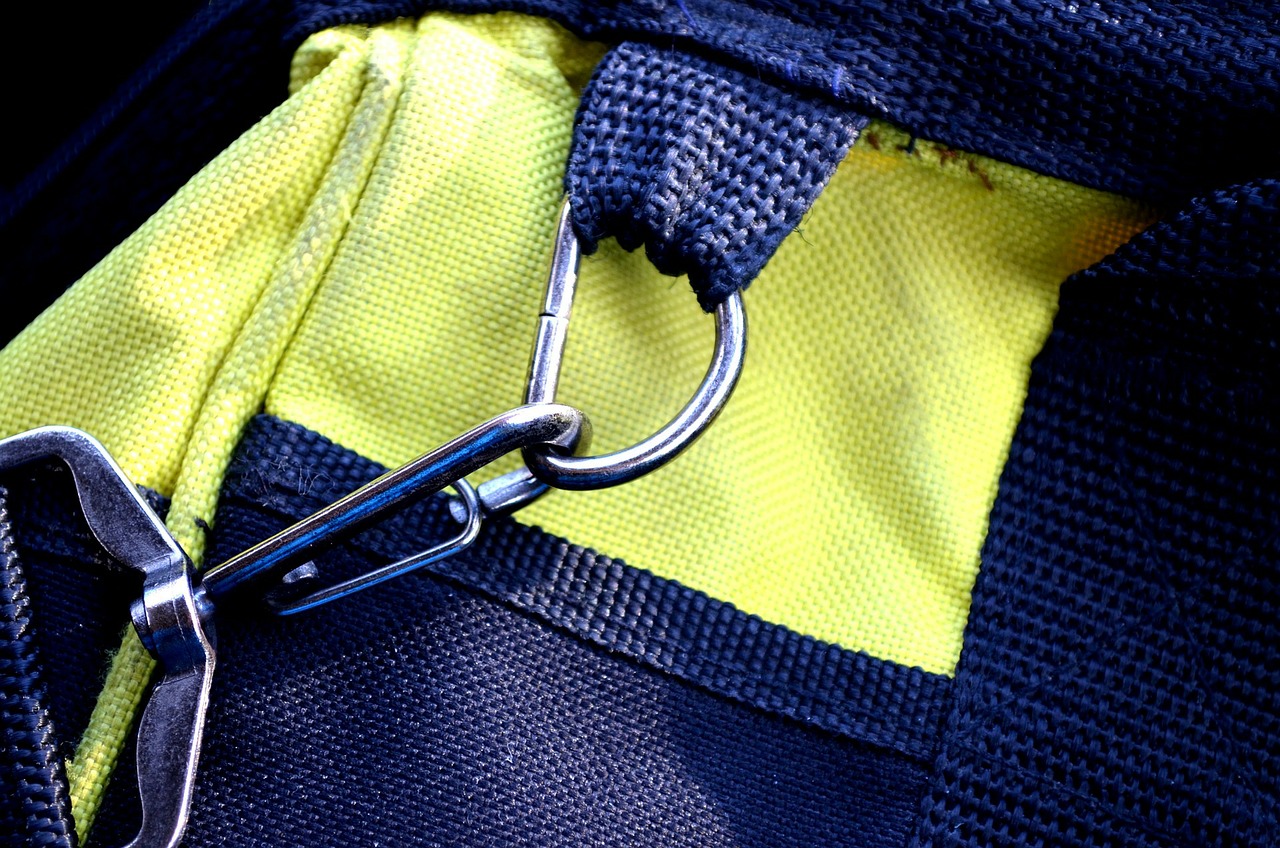
Carabiners Accessory – Image source: Pixabay
- Carabiners stand out due to their sturdiness. You will find them in a hiker’s or climber’s kit. If you plan a trip into the wild, do not forget to take with you straps which own this accessory.
- Metal or plastic rings have a classic look and do not break easily. They are great for keys and trinkets.
Manufacturers also keep their warehouses: swivel clasps, plastic hooks, square clips, oval hooks, and many others.
You ought to choose an accessory which matches your needs and serves your purposes.
Chapter 8. Frequently Asked Questions
1. Can printed lanyards be recycled?
Our products are made of earth-friendly materials. Plus, they are resistant and you don’t have to change them every other week. Another advantage is their multipurpose feature which prevents most people to throw them.
2. Where does the word lanyard come from?
These cords have a long history. They were first mentioned in the 15th century in France. Sailors, soldiers or pirates needed them for their knives, pistols, and other weapons. They named the strings “lanière”.
3. What are retractable screen printed lanyards?
They are special types of straps with a device which adds them an extra length at your will.
4. Where can I find printed lanyards wholesale?
Such items are available in online and offline stores. Lots of online stores belong to factories focused on mass production. They process big orders like the ones for concerts or sports championships.
Conclusion
The technique of screen printing has been around for hundreds of years. It is popular with manufacturers, designers, and customers.
Lanyards customized through this method are eye-catching, solid, and versatile.
Choose Attachment to your custom Screen Printed Lanyards
